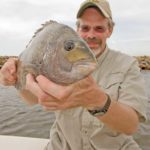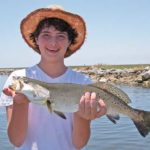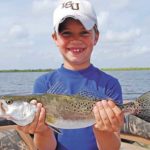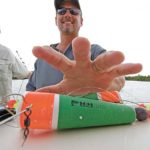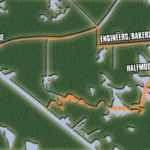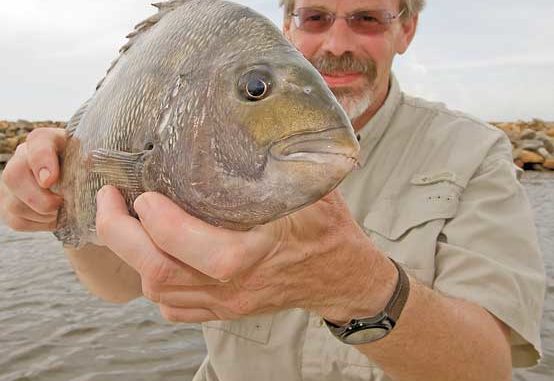
The new dam has altered the hydrology — and the fishing — in this popular eastern St. Bernard area.
In typical bureaucratic style, the U.S. Army Corps of Engineers completed damming the Mississippi River Gulf Outlet on April 22 of this year. While the MR-GO has now become the MR-GONE, some are left wondering what is really gone.
“About the only thing I see gone is the navigation aspect of the canal,” said Capt. C.T. Williams with Big Fish Charters. “Before the dam was built, the main problem associated with the MRGO in a lot of people’s minds was storm surge, saltwater intrusion and coastal erosion.”
The storm surge concern still lingers because there’s no way a rock wall extending 10 feet above the surface of the water will stop a surge like that created by Hurricane Katrina. And while the new dam may help with coastal erosion and saltwater intrusion in places closer to New Orleans, it looks like it will increase the same in other places.
“Once we got in and started to see the effects of the dam being built, we noticed tidal movement changing dramatically,” Williams said. “The dam is forcing water to run in different directions than it did before it was there. We know tidal flow has been restricted in the MRGO, but, unfortunately, it has accelerated in other areas, which is going to create more of an erosion problem at some point in the future.”
Although arguments about the dam and its location near Bayou La Loutre will probably rage on for years, anglers have turned their attention to what the dam will do to the fishing rather than what it will do for hurricane protection.
Williams and fellow charter captain Tim Ursin with Escape Charters agree that the dam hasn’t changed the fishing as much as it has changed the fishing pressure. Whereas the 200 or so boats that launch of out Breton Sound Marina and Campo’s each weekend used to run as far down the channel as they felt comfortable, now the added element of having to traverse the marsh to get below the dam has left some feeling just a little bit intimidated.
“I know we had anglers who used to make a day out of fishing maybe one spot just above where the dam is now and maybe one spot below,” Williams said. “You can’t do that anymore without a lot of effort and time running around, so the dam is definitely changing the way people fish the MRGO.”
Ursin has seen exactly the same thing as Williams in that the anglers who are running down the Back Levee Canal through Alabama are turning right toward the ends of the rocks when they exit Alabama rather than turning left back toward the dam.
“I think a lot of them just don’t want to make a double run to the dam and back,” said Ursin. “That means there are a lot of spots between Alabama and the dam that are getting hardly any fishing pressure at all right now.
“What some are learning, though, is that there is a way to get back into the MRGO without having to run all the way down to the rocks.”
The route that Williams and Ursin are using is easily spotted on any of the standard satellite maps. Simply turn into La Loutre just above the dam and go about two miles before turning right into Engineers, which is also called Baker’s. Following this bayou puts you back out in the MRGO within sight of the dam.
“It’s just going to take some time for people to learn that way around,” Williams said. “There are new maps out already that show the passes to get around the dam without having to run so far down. Slowly and surely, though, people will go with friends who already know, learn the way around and we’ll start to see more people fishing between the dam and Alabama again.”
Although fishing in this stretch has remained relatively unchanged since the dam was finished, the jury is still out on what anglers might find if it takes them too long to find the shortcuts around the dam. In fact, Ursin believes speckled trout, especially, might never find their way to the base of the dam as they transition up the MRGO and into Lake Borgne and Lake Pontchartrain.
“I’ve noticed that the tide doesn’t run very well inside the channel since the closing,” he said. “The water up by the dam has a different color to it, too. It’s more of a dark green rather than that good-green salt water. I don’t think the bait is coming up to the dam as much either. Other than the bait that’s there already, I think most of the bait that moves in now is going to maybe go through Eloi and Half Moon”
Because he doesn’t expect the bait to run up to the bottom of the dam and stop, Ursin doesn’t expect it from the trout either. What might look like a spot for shooting fish in a barrel at first glance might not get replenished with trout as they find other ways to move into Borgne and Pontchartrain.
Ursin believes trout movement patterns will revert back to what they were before the MRGO was dug. That means bigger trout will move in through the deeper water of the Rigolets, whereas the smaller trout will more than likely move through the surrounding marshes.
“There’s no doubt trout were using the MRGO as a straight shot to get to places like Lake Borgne and Seabrook,” Ursin said. “And you might think they’re all going to run up against that dam the next time they move in, but that’s not going to be the case. I think those trout will sense the declining salinity and flow, and they’ll filter off through the deeper bayous in the marsh to get there.”
However, the upcoming change in movement patterns will no doubt open new areas for anglers to fish. Williams believes that’s going to lead to some pros and cons for places like Half Moon, Bakers, Lake Athanasio and Lake Eloi.
While these areas are going to see increased tidal flow, which Williams believes will eventually open this entire area up into Bay Eloi, the influx of salt water, bait and trout will make them potential hotspots in the near future.
“There are plenty of fish in those places right now,” Williams said. “Anglers have been missing them, though, because they’ve been running straight down the middle of the MRGO. Now I expect they’ll start slowing down and fishing some of these areas as their traveling paths change.”
As for the dam itself, Williams says it has the potential to turn into a productive spot before it’s all said and done. Since before the dam was completely closed off, anglers started poking around on it to see what they could find. The combination of moving water with some good clarity to it and baitfish was too much to pass, but many found the fishing to be quite different on the dam than what they were used to.
The way Williams understands the corps’ press releases, the dam is 750 feet wide at the bottom and 10 feet wide at the top. This creates a pyramid of rocks that extends way farther to either side than what one might expect. And as attractive as it may be to all kinds of fish, it’s going to be quite a puzzle to figure out how to best catch them.
“You can throw a cork up tight to the rocks and catch trout when they’re up near the surface,” Williams said. “You can also try dropping to the bottom with a Carolina rig. But the thing that I think is going to explode is fishing a live shrimp or croaker on a drop-shot rig.”
Williams says a drop-shot rig is perfect for fishing the rocks because it helps keep your hooks from hanging in the rocks while still allowing you to get your bait down to the depth of the fish. Although it’s getting more popular, no one has really brought it down to a science yet, and Williams believes whoever can do that will unlock the secret of fishing the new dam.
“I’ve also been playing around with free floating a shrimp or croaker,” Williams said. “You got to be pretty proficient with the Carolina rigs, tightline and even drop-shotting to keep from staying hung all the time. But the lack of current below the dam, you can free line some live bait and allow it to slowly go down across the pyramid of rocks. At some point in the water column, you’re going to find the fish.” U
Contact Capt. C.T. Williams at (504) BIGFISH and Capt. Tim Ursin at (504) 512-2602. Follow the author’s blog at www.chrisginn.com.
